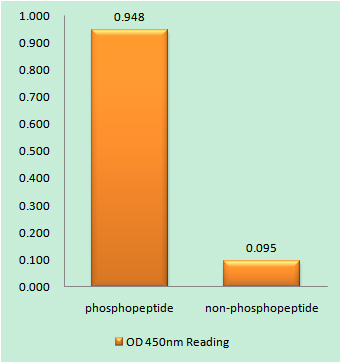NCAM-L1 (phospho Ser1181) Polyclonal Antibody
- Catalog No.:YP0347
- Applications:WB;IHC;IF;ELISA
- Reactivity:Human;Mouse;Rat
- Target:
- NCAM-L1
- Fields:
- >>Axon guidance;>>Cell adhesion molecules
- Gene Name:
- L1CAM
- Protein Name:
- Neural cell adhesion molecule L1
- Human Gene Id:
- 3897
- Human Swiss Prot No:
- P32004
- Mouse Swiss Prot No:
- P11627
- Rat Gene Id:
- 50687
- Rat Swiss Prot No:
- Q05695
- Immunogen:
- The antiserum was produced against synthesized peptide derived from human CD171/N-CAML1 around the phosphorylation site of Ser1181. AA range:1147-1196
- Specificity:
- Phospho-NCAM-L1 (S1181) Polyclonal Antibody detects endogenous levels of NCAM-L1 protein only when phosphorylated at S1181.
- Formulation:
- Liquid in PBS containing 50% glycerol, 0.5% BSA and 0.02% sodium azide.
- Source:
- Polyclonal, Rabbit,IgG
- Dilution:
- WB 1:500 - 1:2000. IHC 1:100 - 1:300. ELISA: 1:20000.. IF 1:50-200
- Purification:
- The antibody was affinity-purified from rabbit antiserum by affinity-chromatography using epitope-specific immunogen.
- Concentration:
- 1 mg/ml
- Storage Stability:
- -15°C to -25°C/1 year(Do not lower than -25°C)
- Other Name:
- L1CAM;CAML1;MIC5;Neural cell adhesion molecule L1;N-CAM-L1;NCAM-L1;CD antigen CD171
- Observed Band(KD):
- 180kD
- Background:
- The protein encoded by this gene is an axonal glycoprotein belonging to the immunoglobulin supergene family. The ectodomain, consisting of several immunoglobulin-like domains and fibronectin-like repeats (type III), is linked via a single transmembrane sequence to a conserved cytoplasmic domain. This cell adhesion molecule plays an important role in nervous system development, including neuronal migration and differentiation. Mutations in the gene cause X-linked neurological syndromes known as CRASH (corpus callosum hypoplasia, retardation, aphasia, spastic paraplegia and hydrocephalus). Alternative splicing of this gene results in multiple transcript variants, some of which include an alternate exon that is considered to be specific to neurons. [provided by RefSeq, May 2013],
- Function:
- disease:Defects in L1CAM are a cause of partial agenesis of the corpus callosum [MIM:304100]; a X-linked disorder.,disease:Defects in L1CAM are the cause of hydrocephalus due to stenosis of the aqueduct of Sylvius (HSAS) [MIM:307000]. Hydrocephalus is a condition in which abnormal accumulation of cerebrospinal fluid in the brain causes increased intracranial pressure inside the skull. This is usually due to blockage of cerebrospinal fluid outflow in the brain ventricles or in the subarachnoid space at the base of the brain. In children is typically characterized by enlargement of the head, prominence of the forehead, brain atrophy, mental deterioration, and convulsions. In adults the syndrome includes incontinence, imbalance, and dementia. HSAS is characterized by mental retardation and enlarged brain ventricles.,disease:Defects in L1CAM are the cause of mental retardation-aphasia-shuffl
- Subcellular Location:
- Cell membrane ; Single-pass type I membrane protein . Cell projection, growth cone . Cell projection, axon . Cell projection, dendrite. Colocalized with SHTN1 in close apposition with actin filaments in filopodia and lamellipodia of axonalne growth cones of hippocampal neurons (By similarity). In neurons, detected predominantly in axons and cell body, weak localization to dendrites (PubMed:20621658). .
- Expression:
- Epithelium,Fetal brain,Liver,Pancreas,Plasma,
- June 19-2018
- WESTERN IMMUNOBLOTTING PROTOCOL
- June 19-2018
- IMMUNOHISTOCHEMISTRY-PARAFFIN PROTOCOL
- June 19-2018
- IMMUNOFLUORESCENCE PROTOCOL
- September 08-2020
- FLOW-CYTOMEYRT-PROTOCOL
- May 20-2022
- Cell-Based ELISA│解您多样本WB检测之困扰
- July 13-2018
- CELL-BASED-ELISA-PROTOCOL-FOR-ACETYL-PROTEIN
- July 13-2018
- CELL-BASED-ELISA-PROTOCOL-FOR-PHOSPHO-PROTEIN
- July 13-2018
- Antibody-FAQs
- Products Images

- Enzyme-Linked Immunosorbent Assay (Phospho-ELISA) for Immunogen Phosphopeptide (Phospho-left) and Non-Phosphopeptide (Phospho-right), using CD171/N-CAML1 (Phospho-Ser1181) Antibody

- Western blot analysis of lysates from K562 cells, using CD171/N-CAML1 (Phospho-Ser1181) Antibody. The lane on the right is blocked with the phospho peptide.

- Immunohistochemical analysis of paraffin-embedded human tonsil. 1, Tris-EDTA,pH9.0 was used for antigen retrieval. 2 Antibody was diluted at 1:200(4° overnight.3,Secondary antibody was diluted at 1:200(room temperature, 45min).



